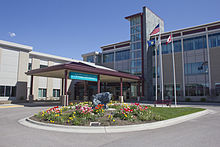Kalispell Regional Medical Center, the flagship of Kalispell Regional Healthcare, which serves a large area in the Rockies.
Hospitals & Health Networks reports on how Kalispell Regional Healthcare, based in Kalispell, Mont., coordinates care and cuts ER visits.
The goals: Identifying high-cost, high-use patients and reducing unnecessary use of resources by improving care coordination and communication across the wider community. That includes, besides healthcare, housing, transportation, meals and social-safety-net resources. The model also includes intensively using tablet technology as a way for rural patients to communicate better with providers.
The model uses “ReSource teams” that include primary-care physicians, pharmacists, nurses, behavioral-health professionals and community health workers.
H&HN reports that “Unlike a traditional transitional care model, which adds resources to a dense geographic area, ReSourcing would bring together new and existing community resources and technologies to develop an intervention team covering a broader geographic range.”
“In this community-based approach, the ReSource nurse acts as a care coordinator for the patient and does medical assessments, caregiver burden assessment, patient safety assessment, patient and caregiver education and medication reconciliation. The ReSource nurse also coordinates with the physician and helps to establish the patient’s medical home. Community health workers augment the nonmedical care and break down barriers to care, including many social determinants of health, such as lack of transportation, secure housing and food. In addition, a behavioral health consultant helps the team develop strategies to work with patients who have coinciding mental health needs. Teams teach patients self-reliance and move them toward primary care management….”
“A nurse visits the patient prior to discharge from the hospital to determine the need and appropriateness for participation in the program. If the individual is enrolled in the program, the ReSource nurse will visit within the first week of discharge to home and gather clinical information. That information can then be shared with the community health worker who will focus on the social determinants of health. Tablet computers are used to facilitate communication between patients at home and members of the ReSource team in the hospital….’’
“The community health worker and ReSource nurse will make additional visits and, after 30 days, assess symptoms, review care plan compliance and evaluate progress on socialization. That information will be shared with the ReSource team. The patient may then graduate, extend enrollment or be referred to his or her medical home.”
To read the whole case study, please hit this link.




